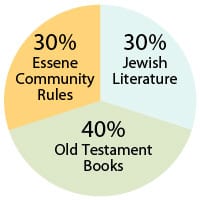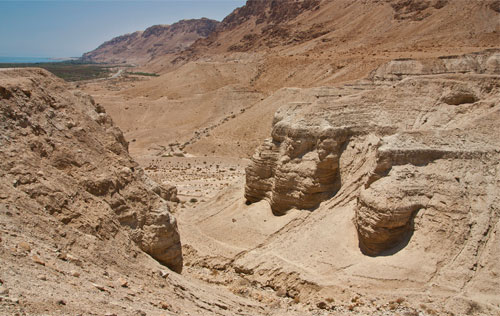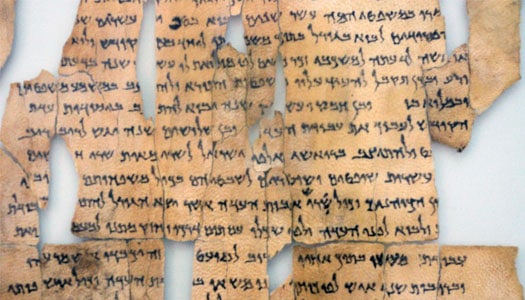Have you ever put together a puzzle with 1,000 pieces? Imagine working on a puzzle with 15,000 pieces! Scholars from Israel, the United States and Great Britain worked carefully to piece together tens of thousands of sections of the Dead Sea Scrolls after the first cave with hidden scrolls was discovered in Israel in 1947.
The details are a bit fuzzy on how the scrolls were found, but most historians agree that in 1946 or 1947, a Bedouin shepherd boy was looking for a lost goat and stumbled upon a cave. He threw a stone into the dark cave and heard it crash into something. Curious, he went to investigate.
The boy discovered large pottery jars, most with airtight lids. Reaching into a jar, he found brittle, leather casings holding ancient scrolls.
The shepherd boy told friends back home what he’d found. Many of the adults returned to the cave with him. Together they found seven scrolls written primarily in Hebrew. The first two scrolls were hand-written copies of the book of Isaiah. The other scrolls contained a paraphrase of Genesis, teachings on the book of Habakkuk, and a book of community rules.
The first scholar to see a fragment of the scrolls was professor Eleazer Sukenik of Hebrew University in Israel. Professor Sukenik said, “My hands shook as I started to unwrap one of them. I read a few sentences. It was written in beautiful biblical Hebrew. The language was like that of the Psalms.”
After the discovery of the scrolls was announced in 1948, archeologists and scholars joined the search at Qumran. By 1956, they found more than 800 scrolls in 11 caves near the Dead Sea. One cave contained 520 documents in more than 15,000 fragments. Now that’s a puzzle!
Scholars began to piece the scrolls together, and with the possible exception of the book of Esther, they identified sections of every Old Testament book of the Bible!
Who put the scrolls there?
After archeologists found the 11 caves, they began to dig deeper in what was thought to be an ancient cemetery in Qumran near the caves. After years of digging, they found an organized central community with rooms, roads, a watchtower and even a scriptorium where scribes hand copied Scripture. The scriptorium even held a low table, 17 feet long, where scroll sections could be laid out and sewn together. Most archeologists agree that the writers of the scrolls, probably the Essenes, occupied this site.
The Essenes were Jews who believed in living a holy life and looking for the coming Messiah. They lived in communities and shared their belongings and their love for God. However, the Essenes’ greatest desire and calling from God seems to have been to carefully copy and watchfully protect the Scriptures.
When the Roman army advanced into Judea during the Jewish Revolt of A.D. 66 to 70, the Essenes hid their entire library of scrolls in the caves. Many of the people hid in caves, too. The Roman army destroyed the community on their way to Jerusalem, but they never discovered the hidden treasures of Scripture.
What were the scrolls made of?
The scrolls were made of parchment, papyrus or leather. They were so brittle and easily broken that some of the scrolls took years to unroll.
The Temple Scroll, so named because it describes the building of the temple of Jerusalem, measured the longest at 26.7 feet. The only scroll made of copper lists 67 spots in Israel and Palestine where treasures were hidden!
When were the scrolls written?
Scholars agree that most of the Dead Sea Scrolls were written 100 to 200 years before Christ was born. We now know for sure that the prophecies about Christ we read in today’s Bibles are identical to those written long before His birth!
Are the scrolls really that important?
The discovery of the Dead Sea Scrolls is said to be the greatest archeological discovery of the 20th century. Those scrolls are 1,000 years older than the oldest biblical manuscripts previously on record. Scholars who have compared the Dead Sea Scrolls with the same books in our Bible today have found that what we read now is a 99.99 percent accurate copy of the original writings.
The amazing discovery of the Dead Sea Scrolls shows, once again, that we can trust that what the Bible says is true. That makes the hours upon hours of putting all those pieces together worth the effort!
Know the Scrolls
Not only did scholars find pieces from nearly every Old Testament book of the Bible⎯they found multiple copies of several books!
|
Book: |
Copies: |
The scrolls are carefully written copies of various manuscripts.
 |
The scrolls were found near Qumran in a rocky, sandy area just north of the Dead Sea. This area has tall limestone cliffs and jutting rocky crags that are nearly impossible to climb.
 |













